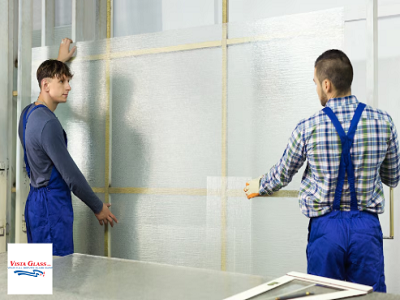Handling broken glass requires caution to avoid injury and ensure safe cleanup. Whether you’re dealing with a shattered window or a broken glassware item, the proper techniques and precautions are essential. The first step is to ensure your safety by wearing thick gloves and shoes to protect your hands and feet from sharp edges. It’s important to carefully pick up the larger pieces of glass first and dispose of them in a sturdy container. Afterward, use a broom and dustpan to collect smaller shards, or even tape up any remaining pieces to make cleanup easier.
When it comes to glass repair, it’s essential to assess the extent of the damage before deciding whether to fix it yourself or call in a professional. Minor cracks may be manageable with repair kits, but extensive breakage often requires replacement or expert repair services. Whether fixing or replacing, taking precautions during glass repair ensures that your home or business stays safe and intact.
Proper Safety Gear for Glass Cleanup
When cleaning up broken glass, wearing appropriate safety gear is essential. Thick gloves, preferably leather or heavy-duty rubber, protect your hands from cuts, while sturdy footwear guards your feet against sharp shards. Eye protection is also recommended if you’re working with larger pieces that could potentially cause flying fragments. Wearing long sleeves can help prevent injuries to your arms, adding an extra layer of safety.
By having the right safety gear, you minimize the risk of injury and ensure the cleanup process is more efficient. This protective equipment also allows you to focus on gathering and disposing of the glass with greater confidence, knowing that you are shielded from potential harm.
Selecting the Right Gloves for Protection
Wearing gloves that are thick and durable, such as leather or heavy-duty rubber, is key when cleaning broken glass. These gloves protect your hands from sharp edges and prevent cuts. It’s important to ensure they fit snugly, allowing you to handle glass pieces safely and securely. Opt for gloves that offer dexterity as well, making cleanup more efficient without sacrificing protection.
Choosing Sturdy Footwear for Safety
Wearing sturdy footwear, such as boots with thick soles, is vital for protecting your feet from glass shards. Open-toed shoes or sandals should be avoided during glass cleanup, as they offer no protection. Footwear with a solid grip also helps reduce the risk of slipping while handling broken glass, ensuring that you can focus on the task at hand without worrying about stepping on hidden pieces.

Eye Protection for Added Safety
When dealing with broken glass, it’s crucial to wear eye protection, especially when working with larger pieces. Flying glass shards can cause serious eye injuries, making protective goggles or safety glasses an important part of your gear. Even if the breakage seems minor, always take precautions to protect your eyes from fragments that could easily fly into the air.
Wearing Long Sleeves for Full Protection
Long sleeves provide additional protection when cleaning up broken glass. They shield your arms from potential cuts or scratches caused by sharp glass fragments. Opting for thicker fabrics like denim or heavy cotton can further reduce the risk of injury. By covering your arms, you ensure that you are well-protected while reaching into areas where glass may be scattered or hidden.
Ensuring Proper Fit of Safety Gear
To maximize the effectiveness of your safety gear, ensure it fits properly. Ill-fitting gloves, shoes, or eye protection can reduce their effectiveness and increase the likelihood of injury. Check that your gloves provide a secure grip, shoes offer ample protection and comfort, and goggles or glasses fit snugly around your face. Proper-fitting gear guarantees you stay safe and maintain focus during cleanup.
Assessing the Extent of the Damage
Before taking any further steps, it’s important to assess how much damage has occurred. Small cracks in glass can often be repaired with simple kits or adhesives, whereas large breaks, especially in windows or doors, may require complete replacement. Taking time to evaluate the situation helps determine the best course of action, whether it’s repairing or calling in a professional.
If you’re unsure about the severity of the break, it’s better to err on the side of caution. For large cracks or shattered glass, it’s usually safer to opt for professional glass repair services. A proper assessment will save you time, effort, and money in the long run, preventing further damage or mistakes.
Cleaning Up the Larger Glass Pieces
Once you’ve secured the necessary safety gear, begin by gathering the larger pieces of broken glass. Use a broom or thick cardboard to carefully collect and dispose of the pieces, ensuring none are left behind. Avoid using your hands directly, as they could be cut, even through gloves. Be mindful of hidden shards that may be scattered in the surrounding area.
For easier cleanup, consider using duct tape or sticky paper to pick up the smaller, difficult-to-see fragments. Thoroughly inspect the area after gathering the bulk of the pieces to ensure no sharp shards are missed, as they can easily cause injuries if not properly dealt with.
Utilizing the Right Tools for Cleanup
Using the right tools can make cleaning broken glass much easier and safer. A broom and dustpan are ideal for gathering larger shards, while tape, a vacuum cleaner, or sticky gloves can help collect smaller pieces. Additionally, using a damp paper towel or rag can help pick up any tiny glass fragments left on the floor after sweeping.
If you’re dealing with a broken glass window or a large piece, specialized tools like a glass cutter or breaker may be necessary for safer handling. Having the right tools ensures that the entire cleanup process is as effective and efficient as possible while reducing the risk of injury.
Proper Disposal of Broken Glass
Proper disposal of broken glass is crucial to ensure that no one else is injured. Always place larger pieces in a sturdy, puncture-proof container such as a cardboard box, thick plastic bag, or a strong trash bin. Avoid throwing broken glass directly into a standard garbage bag, as it can easily tear and pose a danger to garbage collectors or others.
Additionally, label the container as “broken glass” to alert anyone handling the waste. This simple step can prevent accidental injuries during waste collection or disposal. If the glass is too large or heavy for regular trash bins, consider taking it to a local recycling center or contacting a professional for proper disposal options.
Choosing Glass Repair Over Replacement
For minor cracks or small chips, repairing the glass rather than replacing it can be a cost-effective solution. Many glass repair kits are available that allow you to fix small damages on your own. These kits usually include resin or epoxy that bonds the cracked glass together, making it look nearly new.
However, this approach works best for glass in non-load-bearing areas, such as decorative glass or some types of window panes. For larger or structural damage, it’s best to consult a professional. In some cases, attempting to repair severely damaged glass can result in further harm or reduce the integrity of the structure.
When to Call a Professional for Glass Repair
Certain instances call for professional help when dealing with broken glass. If the glass is part of a complex or large structure, such as a window, mirror, or glass door, replacing it might require specialized skills or equipment. Professionals have the necessary expertise to safely replace broken glass, ensuring the area is properly sealed and the glass is installed securely.
Additionally, professionals can handle larger or more dangerous breakages, including those involving tempered glass or glass used in high-risk areas, such as vehicles. Calling an expert can save you time, money, and potential safety risks, ensuring that the job is completed properly and without complications.
Taking Preventative Measures to Avoid Breakage
Preventing glass from breaking in the first place can save a lot of hassle. Consider installing protective films or coatings on windows to reduce the likelihood of shattering. For furniture, using tempered glass or securing heavy items can reduce the chances of accidents. Also, be cautious during cleaning or moving items near glass surfaces to avoid putting unnecessary pressure on them.
Proper maintenance of your glass surfaces, such as checking for early signs of cracking, can also help prevent more severe damage. By being proactive and maintaining a safe environment, you can minimize the risks associated with broken glass and keep your space safer for everyone.
Conclusion
Handling broken glass safely is crucial to prevent injury and damage. By following the proper steps—such as wearing protective gear, clearing the area, and disposing of the shards responsibly—you can ensure a safe environment for yourself and those around you. Always use caution and be prepared when dealing with glass fragments, as they can pose serious risks if not handled correctly.
If you ever find yourself in need of professional glass repair or replacement services in Tucson, Vista Glass is here to help. Our team of experts ensures fast and reliable service to restore your glass safely and efficiently. For more information or to schedule a consultation, feel free to contact us today!

